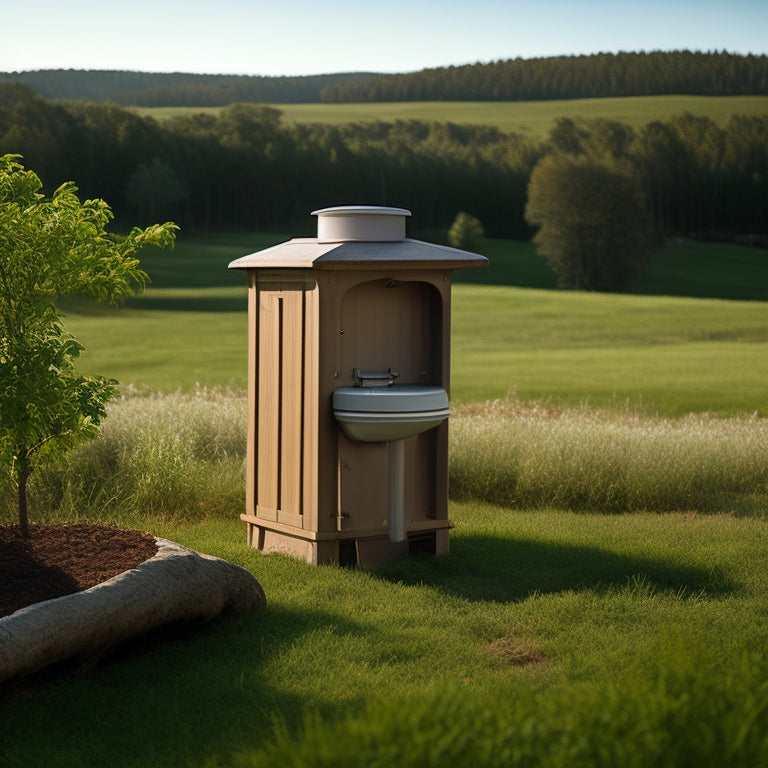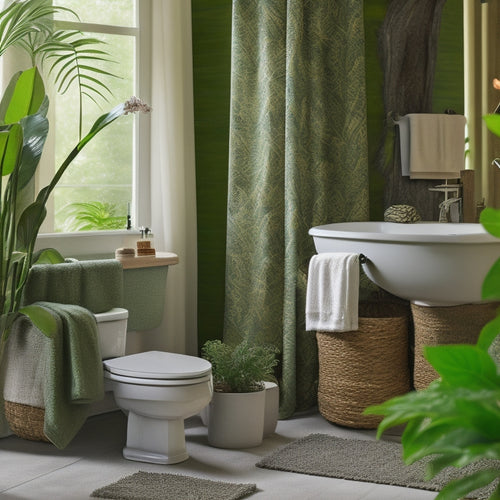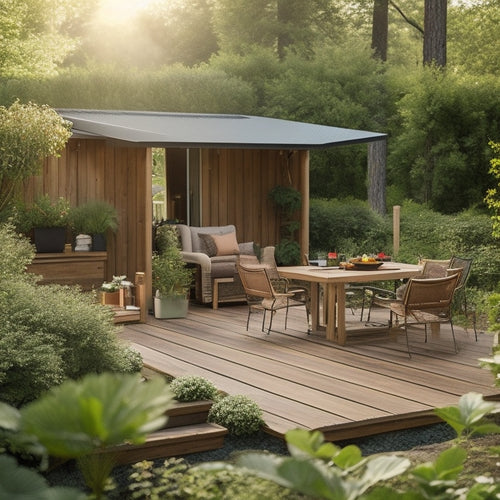
What's Involved in Setting Up a Composting Toilet?
Share
You'll need to choose the right composting toilet for your needs, considering factors like installation costs, space requirements, and water efficiency. Assess your water supply to guarantee you can support the toilet's needs, and select a composting method that suits your energy efficiency goals. You'll also need to plan for ventilation, installation, and electrical connections. Additionally, you'll need to maintain the composting system, managing moisture, oxygen, and temperature levels, and periodically removing finished compost. As you continue to set up your composting toilet, you'll uncover the complexities of this sustainable waste management solution.
Key Takeaways
- Evaluating toilet features, installation costs, and space requirements is crucial for choosing the right composting toilet for your needs.
- Assessing water supply and conservation methods, such as rainwater harvesting and greywater recycling, is essential for sustainable operation.
- Selecting a suitable composting method, like aerobic or vermicomposting, and determining capacity requirements is vital for efficient waste management.
- Creating an installation plan, including toilet location, ventilation, and electrical connections, ensures a successful and compliant setup.
- Properly installing the toilet and tank, following manufacturer guidelines, is necessary for secure and efficient operation.
Choosing the Right Composting Toilet
When venturing into the world of composting toilets, selecting the right one for your needs is vital.
You'll want to contemplate toilet features that align with your user preferences, such as self-contained or central systems. Evaluate the environmental impact of each model, as well as installation costs and space requirements.
Maintenance frequency, odor control, and aesthetic choices are also significant factors. Research product reviews and brand comparisons to narrow down your options.
To reduce costs, it's important to optimize your system design and select energy-efficient equipment, which can also be applied to other sustainable practices.
Some models may require more frequent emptying, while others may have advanced odor-control systems. By assessing these factors, you'll find a composting toilet that fits your lifestyle and promotes a more sustainable future.
Assessing Your Water Supply
You'll need to assess your water supply to guarantee it can support a composting toilet. First, you'll want to check your water availability to determine how much water you can realistically conserve.
Moreover, you'll need to take into account local water restrictions and investigate water conservation methods to minimize your toilet's water usage.
In addition, implementing time-of-use rate strategies energy-efficient solutions can help reduce your energy costs, and optimizing your water usage can have a positive impact on your overall energy consumption.
Water Availability Check
Before installing a composting toilet, someone needs to assess the water supply at the potential installation site.
You'll want to determine if you have a reliable source of water and if it's sufficient for your needs. This is essential, as composting toilets require water for flushing and maintaining the composting process.
Additionally, considering the environmental impact of your water usage is important, as it can contribute to greenhouse gas emissions and affect the overall sustainability of your composting toilet.
To assess your water supply, consider the following factors:
- Water source: Is it a municipal connection, well, or rainwater harvesting system?
- Water quality: Is the water clean and free of contaminants that could affect the composting process?
- Water quantity: Is there enough water available to support the toilet's flushing needs, as well as other household uses?
- Climate considerations: Are you in an area prone to drought or water scarcity, which could impact your water recycling capabilities?
Water Conservation Methods
About 20 gallons of water per day are typically required to support a composting toilet, making water conservation an essential aspect of evaluating your water supply. To guarantee you have a sufficient water supply, consider implementing water conservation methods.
| Method | Description |
|---|---|
| Rainwater Harvesting | Collecting and storing rainwater for non-potable uses, such as flushing the toilet. |
| Greywater Recycling | Reusing water from sinks, showers, and washing machines for irrigation and flushing. |
| Low-Flow Fixtures | Installing low-flow showerheads, faucets, and toilets to reduce water consumption. |
| Water-Efficient Appliances | Using appliances that use less water, such as low-water washing machines and dishwashers. |
Local Water Restrictions
Evaluating your water supply involves understanding local water restrictions, which can greatly impact your composting toilet's operation. Before installing a composting toilet, you need to determine if your area has any water conservation measures in place.
These restrictions can affect how much water you're allowed to use for flushing, which in turn affects the type of composting toilet you can install. It's crucial to assess energy needs and infrastructure assessing energy needs to facilitate a seamless shift to renewable energy solutions.
Similarly, evaluating your water supply helps you choose the right composting toilet for your needs.
Check your local regulations for the following:
- Water usage limits: Are there restrictions on how much water you can use per day or per flush?
- Water conservation goals: Are there incentives or penalties for meeting or exceeding water conservation targets?
- Alternative water sources: Are you allowed to use rainwater or greywater for flushing or irrigation?
- Composting benefits: Are there any local regulations that promote the use of composting toilets, such as rebates or tax credits?
Selecting a Composting Method
You'll need to choose a composting method that suits your needs and preferences, taking into account factors like energy efficiency and system sizing assessing energy needs.
This will help you determine the right capacity for your composting toilet setup. There are several types of composting to evaluate, including worm composting methods that employ microorganisms to break down waste, and self-contained systems that provide a compact, odor-free solution.
Types of Composting
When choosing a composting method, it's essential to evaluate the specific requirements and limitations of your composting toilet system, as different approaches cater to varying needs and environments.
You'll need to take into account factors like moisture levels, oxygen flow, and temperature control to guarantee ideal microbial activity.
Here are four common types of composting methods to take into account:
-
Aerobic composting: This method relies on oxygen-rich conditions to break down organic matter, often using aeration systems or turning mechanisms to maintain oxygen flow.
-
Anaerobic composting: This method occurs in the absence of oxygen, resulting in a slower process that requires more careful bin design and monitoring.
-
Vermicomposting: This method employs worms to break down organic matter, requiring a specific bin design and maintenance routine.
- Bokashi composting: This method uses microorganisms to ferment organic matter in a sealed container, often producing a nutrient-rich liquid fertilizer.
Worm Composting Methods
Your worm composting setup's success depends on choosing the right worm composting method, which involves selecting the ideal worm species, bin design, and maintenance routine for your composting toilet system.
You'll need to decide on a vermiculture technique that suits your needs, such as continuous flow or batch processing. The worm species you choose will also impact your system's performance; red wiggler worms (Eisenia fetida) are a popular choice due to their high composting capacity and tolerance for varying temperatures and moisture levels.
A well-designed bin with adequate aeration, moisture control, and temperature regulation is also essential for maintaining a healthy worm population and ideal composting conditions.
Self-Contained Systems
Self-contained systems for composting toilets offer a straightforward approach to managing human waste, as they're designed to process waste within a single, enclosed unit.
This setup is ideal for small households, cabins, or tiny homes, where space is limited.
You'll appreciate the system benefits, including:
-
Easy maintenance: Self-contained systems are generally low-maintenance, with fewer components to manage.
-
Odor control: The enclosed design minimizes odors and messes, providing a more pleasant user experience.
-
Water efficiency: These systems often use little to no water, making them ideal for water-conscious users.
- Space-saving design: Self-contained composting toilets are compact, freeing up useful space in your home or cabin.
Understanding Ventilation Requirements
Proper ventilation is key to maintaining a healthy and odor-free composting toilet system.
You'll want to guarantee natural airflow is maximized to facilitate efficient decomposition and odor control. A well-ventilated system allows carbon dioxide to escape, reducing the risk of anaerobic conditions that encourage unpleasant odors.
You'll need to take into account the type of ventilation system required, such as a fan-powered vent or a passive vent pipe. The vent pipe should be installed to allow for a gentle, continuous flow of air out of the toilet, while also preventing insects and rodents from entering.
Creating an Installation Plan
As you prepare to install your composting toilet, creating a detailed installation plan is essential to guarantee a smooth and successful process.
This plan will help you guide the installation process, ensuring you reap the composting benefits while meeting regulatory considerations.
When creating your plan, regard the following key factors:
-
Toilet location: Determine the ideal location for your composting toilet, considering ventilation requirements and accessibility.
-
Electrical connections: Identify the power sources needed for your toilet's fans, heaters, or other components.
-
Water supply: Decide how you'll manage liquid waste, including greywater reuse or disposal.
- Maintenance access: Guarantee easy access to the toilet's internal components for regular maintenance and upkeep.
Preparing the Bathroom Space
When preparing the bathroom space for your composting toilet, you'll need to evaluate the layout to guarantee a functional and efficient area.
You'll have to decide on the ideal location for the toilet, factoring in elements like space constraints and accessibility.
Additionally, you'll need to plan for adequate ventilation to maintain a healthy and odor-free environment.
Bathroom Layout Considerations
You'll need to allocate approximately 1-2 square feet of floor space for the composting toilet, depending on the model you choose.
When planning your bathroom layout, consider the following factors to guarantee space efficiency and accessibility features:
-
Clearance: Verify there's enough clearance around the toilet for comfortable use and maintenance. A minimum of 12 inches on either side is recommended.
-
Ventilation: Composting toilets require adequate ventilation to function effectively. Plan for a vent pipe that can be connected to an external vent or fan.
-
Power supply: If your composting toilet requires power, confirm there's a nearby outlet or plan for alternative energy sources.
- Accessibility: Consider the toilet's height, handle, and seat design to accommodate users with mobility or dexterity limitations.
Toilet Location Options
With the bathroom layout considerations in mind, it's time to investigate toilet location options that will optimize the functionality of your composting toilet.
You'll want to prioritize toilet privacy, ensuring the toilet is situated in a way that provides a comfortable and private experience for users.
Consider the bathroom's traffic flow and place the toilet in a location that minimizes disturbance and maximizes accessibility.
Accessibility considerations are essential, especially for users with mobility issues.
Position the toilet to allow for easy approach and departure, considering any obstacles or barriers that may hinder movement.
Ventilation Requirements Needed
Proper ventilation is crucial in a bathroom equipped with a composting toilet, as it helps remove moisture and odors from the air.
You'll need to confirm your bathroom has a reliable airflow mechanism to maintain a healthy environment.
To achieve the best ventilation, consider the following:
- Install a powerful exhaust fan that can exchange the air at least 10 times per hour.
- Use a vent pipe that's specifically designed for composting toilets, as it will be more effective at odor control.
- Position the vent pipe at least 10 feet above the toilet to minimize odors and moisture re-entering the bathroom.
- Add a vent filter to catch any remaining particles and odors before they're released outside.
Installing the Toilets and Tanks
The concrete slab or wooden platform you've prepared now serves as the foundation for the composting toilet and tank installation. It's crucial to verify proper toilet placement, considering factors like accessibility, ventilation, and aesthetics. Next, determine the tank capacity required based on your water usage and the number of users.
| Toilet Type | Tank Capacity | Recommended Users |
|---|---|---|
| Self-contained | 1-2 gallons | 1-2 people |
| Central system | 5-10 gallons | 3-5 people |
| Large capacity | 20-50 gallons | 6-10 people |
Remember to follow the manufacturer's guidelines for toilet and tank installation, verifying a secure and efficient system.
Connecting to Electricity and Water
You've positioned the composting toilet and tank, guaranteeing a secure and efficient system.
Now, it's time to connect it to the necessary utilities.
To complete the setup, you'll need to establish electrical connections to power the system's fans, heaters, or other components. Additionally, you may need to connect to a water source for flushing or cleaning the toilet.
Here are some key considerations for connecting to electricity and water:
- Verify all electrical connections are waterproof and meet local electrical codes.
- Use a water filtration system to prevent contaminants from entering the composting process.
- Connect to a clean water source, such as a rainwater harvesting system, to reduce your water footprint.
- Consider using a DC-powered system to minimize energy consumption and reliance on the grid.
Maintaining the Composting System
Maintaining the composting system requires attention to temperature, moisture, and oxygen levels to ascertain efficient decomposition and minimize odors.
You'll need to monitor these factors to guarantee ideal conditions for microorganisms to break down waste. Regular compost maintenance involves turning the compost pile to maintain oxygen flow and speed up decomposition.
This also helps with odor control by preventing anaerobic conditions that promote unpleasant smells. Keep an eye on moisture levels, as excessive water can lead to soggy conditions that inhibit microbial activity.
Managing Compost and Waste
Every few weeks, you'll need to remove finished compost from the system to make room for new waste and maintain ideal performance. This step is essential for reaping the compost benefits and maximizing waste reduction.
When removing the compost, you'll notice it's abundant in nutrients and has an earthy aroma.
Here's what you should do with the finished compost:
- Add it to your garden or yard, where it will enhance the soil and support healthy plant growth.
- Use it as a natural fertilizer for your indoor plants.
- Mix it into your potting soil to create a nutrient-rich blend.
- Share it with friends or family who also value sustainable living.
Frequently Asked Questions
Can I Install a Composting Toilet in a Mobile Home?
You can install a composting toilet in a mobile home, but you'll need to guarantee it meets specific installation requirements, such as proper ventilation and electrical connections, and may require mobile home modifications, like floor reinforcements.
Are Composting Toilets Suitable for People With Disabilities?
As you commence on this medieval quest for independence, you'll find composting toilets can be a knight in shining armor for people with disabilities, offering accessibility features like raised seats and design considerations for effortless use.
Can I Compost Pet Waste With Human Waste?
You'll need to follow specific composting guidelines for pet waste management, as mixing it with human waste can create health risks; separate composting systems or specific additives are required to safely process pet waste.
How Do I Handle Toilet Paper in a Composting Toilet?
You'll need to rethink toilet paper usage in your composting toilet; consider alternatives like bamboo wipes or cloth wipes, and prioritize regular maintenance to guarantee a healthy composting process and prevent clogs.
Do Composting Toilets Attract Pests or Insects?
You'll be relieved to know that, with proper pest prevention strategies, your composting toilet won't become a bug buffet. Regular composting toilet maintenance, like turning the compost and ensuring adequate carbon-to-nitrogen ratios, will keep unwanted critters at bay.
Related Posts
-

10 Best WiFi Outlets for Tracking Home Energy Usage
You can optimize your home's energy usage with the right WiFi outlets, which provide real-time monitoring and control...
-

Sustainable Scrubbing: Top Bathroom Solutions for Earth-Conscious Homes
You're taking an important step towards creating a more sustainable home by switching to eco-friendly bathroom cleani...
-

Green Deck Options: Earth-Conscious Choices for Your Home
You're looking for a deck that not only enhances your home's exterior but also aligns with your eco-friendly values. ...


